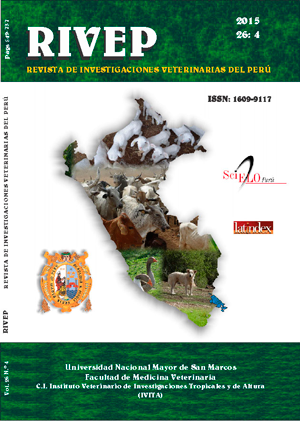Evaluation of three avian infectious laryngotracheitis vaccination programmes using two commercial vectorized vaccines in broilers
DOI:
https://doi.org/10.15381/rivep.v26i4.11204Keywords:
laryngotracheitis, vaccination, recombinantAbstract
The aim of this study was to evaluate the protection of three immunization programmes against infectious laryngotracheitis (ILT) in broilers using two recombinant commercial vaccines. A total of 288 1-day-old Ross-308-line male birds were distributed in four experimental groups of 72 animals with three replicates of 24 birds per group. Group A was subcutaneously vaccinated at 1 day of age with a commercial recombinant fowlpox virus (FPV)-vectored vaccine expressing ILT virus (ILTV) glycoprotein B gene; Group B was vaccinated at day 14 of age with an inactivated vaccine by subcutaneous route and with the vaccine of Group A but applied via wing-web puncture; Group C was subcutaneously vaccinated at 1 day of age with HVT recombinant commercial vaccine expressing genes encoding for ILTV glycoproteins I and D; and Group D remained unvaccinated. All birds were challenged with ILTV pathogenic strain with 107 DIE50 at 35 days of age. Unvaccinated chicks showed higher degree of respiratory signs on day 6 post challenge than the vaccinated ones (p<0.05). Microscopic lesions varied between groups, but group C presented a faster recovery (p<0.05). Production parameters (body weight, feed conversion index, and European productive efficiency index) showed no significant difference between groups. The best protection against ILT was obtained in birds vaccinated with the HVT recombinant vaccine; however, no difference in productive performance was found between treatments.Downloads
Downloads
Published
Issue
Section
License
Copyright (c) 2015 Silvia Charca P., Eliana Icochea D’A., Rosa González V., Rosa Perales C., Viviana San Martín D., Nelly Cribillero C., Pablo Reyna S.

This work is licensed under a Creative Commons Attribution-NonCommercial-ShareAlike 4.0 International License.
AUTHORS RETAIN THEIR RIGHTS:
a. Authors retain their trade mark rights and patent, and also on any process or procedure described in the article.
b. Authors retain their right to share, copy, distribute, perform and publicly communicate their article (eg, to place their article in an institutional repository or publish it in a book), with an acknowledgment of its initial publication in the Revista de Investigaciones Veterinarias del Perú (RIVEP).
c. Authors retain theirs right to make a subsequent publication of their work, to use the article or any part thereof (eg a compilation of his papers, lecture notes, thesis, or a book), always indicating the source of publication (the originator of the work, journal, volume, number and date).










